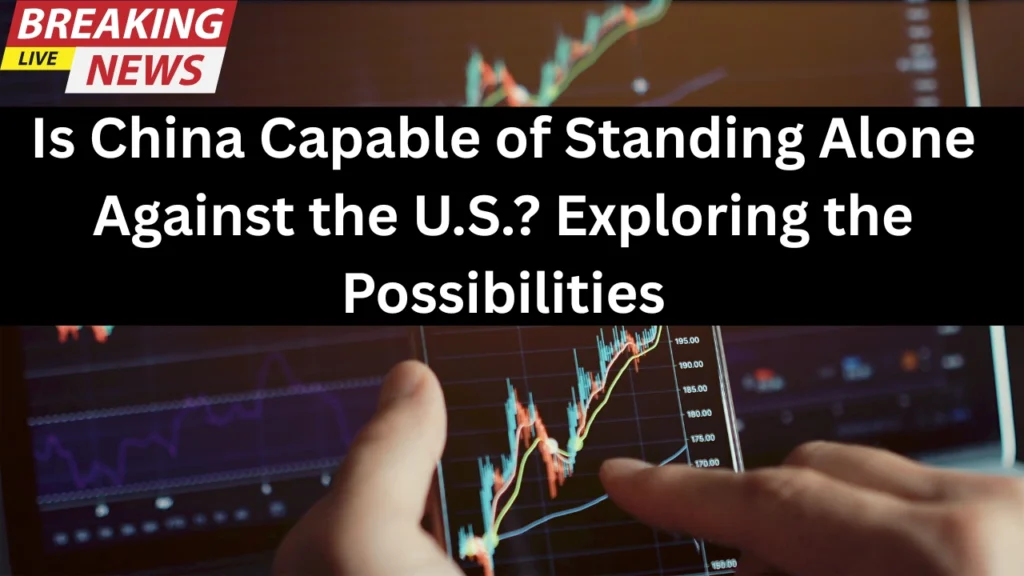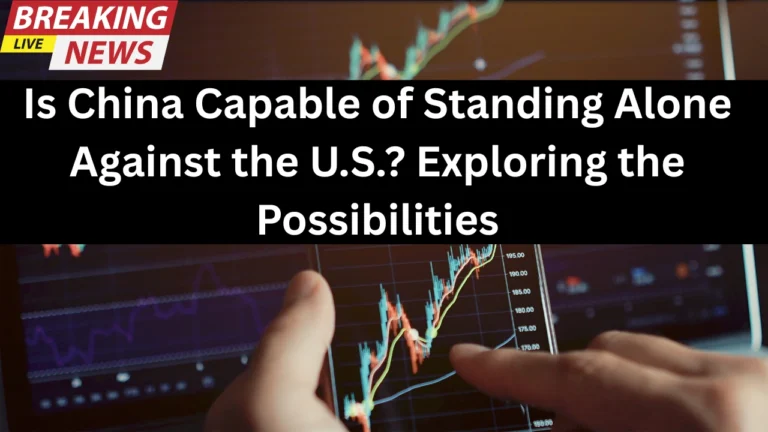As cranes glide above the Rambler Channel in Hong Kong, tirelessly moving containers in and out of port, the gears of globalization continue to turn. Beneath the calm choreography of trucks, cranes, and container ships, however, the world has crossed a significant threshold. At noon on April 9, the United States imposed a devastating 125% tariff on Chinese imports—marking a new escalation in the trade war that is redefining global economic dynamics.

Despite the routine hum of logistics, this moment symbolizes a critical question echoing from Washington to Beijing and beyond:
Can China stand alone against the United States economically, militarily, and diplomatically?
Wishful thinking at best…besides China has escalation dominance and even hasn't started to retaliate
— StarBoySAR 🇭🇰 🇨🇳 🥭 (@StarboySAR) April 10, 2025
The fundamental reason for America’s weakness lies in the decline of its manufacturing sector and financialization of its economy. The belief that “imposing tariffs can… pic.twitter.com/egSzF90zCL
Let’s explore the possibilities.
Economic Front: Trade War Without a Truce
China’s response to President Donald Trump’s aggressive tariff hikes has been equally combative. A tit-for-tat pattern has emerged:
- April 2: Trump imposes 34% tariffs on Chinese imports.
- China retaliates immediately with the same.
- Trump responds with 84% tariffs, which are again mirrored.
- Finally, on April 9, the U.S. raises tariffs to 125%—after including an earlier 20% penalty for China’s alleged role in fentanyl trafficking.
These numbers aren’t just percentages. They reflect the collapse of mutual trust between two economic superpowers that together account for over 40% of global GDP.
Yet despite the blow, China’s ports remain functional, and its trade with countries other than the U.S. continues largely undisturbed. The Chinese economy is adapting—leveraging intra-Asian trade, BRI (Belt and Road Initiative) partnerships, and regional FTAs like RCEP (Regional Comprehensive Economic Partnership).
However, China’s economic power is deeply integrated with Western markets—especially the U.S.—in sectors like:
- Electronics & semiconductors
- Pharmaceutical ingredients
- Automobile parts
- Luxury consumer goods
So, can China stand alone economically?
Short-term: Maybe.
Long-term: Only by reinventing its global trade alliances and domestic innovation.
Military Equation: Strategic Might vs. Global Alliances
In raw numbers, China’s military is second only to the United States. With over 2 million active personnel, cutting-edge hypersonic missiles, and massive investments in artificial intelligence and cyber warfare, Beijing has transformed the People’s Liberation Army (PLA) into a 21st-century force.
But military power is not just about tanks and warships alliances matter.
- The U.S. leads NATO, maintains strong security partnerships in East Asia (Japan, South Korea, Australia), and stations troops globally.
- China, on the other hand, has few true allies—North Korea, Pakistan, and perhaps Russia, the latter more opportunistic than ideologically aligned.
Without a robust alliance system, China is largely isolated militarily. While it can project strength regionally—such as in the South China Sea or near Taiwan—it lacks the global military footprint of the United States.
So, militarily, can China stand alone?
Yes, in defending its interests regionally.
No, in confronting a U.S.-led coalition globally.
Diplomatic Isolation vs. Global Engagement
Beijing champions the principles of sovereignty, non-interference, and multilateralism, often as a counter-narrative to Western liberal democracy. Through organizations like the Shanghai Cooperation Organisation (SCO) and diplomatic campaigns in Africa and Latin America, China has expanded its geopolitical presence.
However, many of China’s diplomatic ties are transactional, not ideological. Countries often engage with China out of economic necessity, not shared values or deep trust.
The U.S., despite its own foreign policy contradictions, still anchors the liberal international order, supported by a network of allies that includes Canada, the EU, the UK, Japan, and Australia.
In the face of global scrutiny over issues like Xinjiang, Hong Kong, and Taiwan, China has often found itself diplomatically defensive, rather than proactive.
So, diplomatically, can China stand alone?
To some extent, yes but it remains vulnerable to global isolation if Western alliances coordinate pressure.
Technology and Innovation: Dependency Meets Ambition
Technology is the new battlefield of the 21st century. China has made massive strides with companies like:
- Huawei (telecommunications)
- BYD (electric vehicles)
- Alibaba and Tencent (digital ecosystems)
Yet, semiconductors remain a critical weakness. Despite efforts like “Made in China 2025”, the country still depends on Western (especially American and Taiwanese) tech for high-end chips and advanced software.
The U.S. ban on chip exports and restrictions on companies like ASML delivering photolithography equipment to China have exposed a deep vulnerability in China’s tech ambitions.
However, with increased state investment, intellectual property acquisition, and rising domestic talent, China is racing toward tech self-reliance.
So, in tech, can China go solo?
Not yet but it’s closing the gap fast. The next decade will be crucial.
Internal Stability: A Key Wildcard
Much of China’s capacity to stand alone hinges on domestic stability:
- Youth unemployment is rising.
- Real estate sector instability, especially with firms like Evergrande, threatens financial confidence.
- A slowing GDP growth rate (below 5%) raises questions about economic momentum.
That said, the Communist Party maintains firm control, and China has shown remarkable resilience in weathering economic and political challenges in the past.
Unlike the U.S., China’s centralized decision-making allows for rapid strategic pivots—an advantage in crises.
Final Analysis: Can China Stand Alone Against the U.S.?
Economically: With pain, yes—especially by pivoting to regional partnerships.
Militarily: Regionally strong, globally vulnerable without allies.
Diplomatically: Active but isolated—global influence remains limited.
Technologically: Still dependent, but closing the innovation gap.
Domestically: Stable, but facing long-term structural pressures.
Conclusion
A unilateral standoff with the U.S. would require strategic patience, regional dominance, domestic innovation, and the ability to build new global alliances that reduce reliance on Western systems.
What’s clear is this: Globalization isn’t dead—but it’s evolving. And the question isn’t just whether China can stand alone, but whether the world can thrive in a world divided between two superpowers on a collision course.

